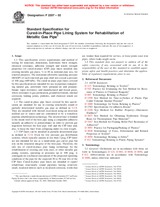We need your consent to use the individual data so that you can see information about your interests, among other things. Click "OK" to give your consent.
ASTM F2207-02
Standard Specification for Cured-in-Place Pipe Lining System for Rehabilitation of Metallic Gas Pipe
STANDARD published on 10.9.2002
The information about the standard:
Designation standards: ASTM F2207-02
Note: WITHDRAWN
Publication date standards: 10.9.2002
SKU: NS-53188
The number of pages: 19
Approximate weight : 57 g (0.13 lbs)
Country: American technical standard
Category: Technical standards ASTM
Annotation of standard text ASTM F2207-02 :
Keywords:
composite, cured-in-place, flexible tubing, gas pipe renewal, inversion, rehabilitation, ICS Number Code 23.040.15 (Non-ferrous metal pipes)
Additional information
| 1. Scope | ||||||||||||||||||||||||||||
|
1.1 This specification covers requirements and method of testing for materials, dimensions, hydrostatic burst strength, chemical resistance, adhesion strength and tensile strength properties for cured-in-place (CIP) pipe liners installed into existing metallic gas pipes, 3/4 to 48 in. nominal pipe size, for renewal purposes. The maximum allowable operating pressure (MAOP) of such renewed gas pipe shall not exceed a pressure of 100 psig (689 kPa). The cured-in-place pipe liners covered by this specification are intended for use in pipelines transporting natural gas, petroleum fuels (propane-air and propane-butane vapor mixtures), and manufactured and mixed gases, where resistance to gas permeation, ground movement, internal corrosion, leaking joints, pinholes, and chemical attack are required. 1.2 The cured-in-place pipe liners covered by this specification are intended for use in existing structurally sound or partially deteriorated metallic gas pipe as defined in . They are installed with limited excavation using an inversion method (air or water) and are considered to be a trenchless pipeline rehabilitation technology. The inverted liner is bonded to the inside wall of the host pipe using a compatible adhesive (usually an adhesive or polyurethane) in order to prevent gas migration between the host pipe wall and the CIP liner and, also, to keep the liner from collapsing under its own weight. 1.3 CIP liners can be installed in partially deteriorated pipe as defined in . Even for low pressure gas distribution systems, which typically operate at less than 1 psig, CIP liners are not intended for use as a stand-alone gas carrier pipe but rely on the structural integrity of the host pipe. Therefore, the safe use of cured-in-place pipe lining technology for the rehabilitation of existing cast iron, steel, or other metallic gas piping systems, operating at pressures up to 100 psig, is contingent on a technical assessment of the projected operating condition of the pipe for the expected 30 to 50 year life of the CIP liner. Cured-in-place pipe liners are intended to repair/rehabilitate structurally sound pipelines having relatively small, localized defects such as localized corrosion, welds that are weaker than required for service, or loose joints (cast iron pipe), where leaks might occur. 1.4 This standard does not purport to address all of the safety concerns, if any, associated with its use. It is the responsibility of the user of this standard to establish appropriate safety and health practices and determine the applicability of regulatory requirements prior to use. |
||||||||||||||||||||||||||||
| 2. Referenced Documents | ||||||||||||||||||||||||||||
|
We recommend:
Technical standards updating
Do you want to make sure you use only the valid technical standards?
We can offer you a solution which will provide you a monthly overview concerning the updating of standards which you use.
Would you like to know more? Look at this page.




 Cookies
Cookies
